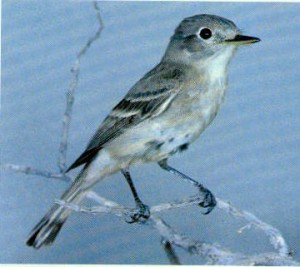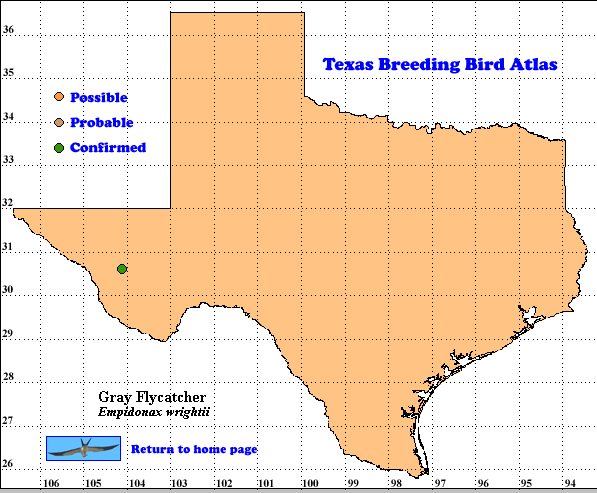The Great Kiskadee is one of the larger and more showy tyrant flycatchers and exhibits an array of interesting behavior. While not an accomplished singer, it has a wider variety of vocalizations than the field guides report. Unlike most tyrant flycatchers, the Great Kiskadee freely displays its bright crown stripe. When especially excited, it erects its yellow crown feathers, forming an ephemeral crest. On rare occasions a displaying kiskadee spreads the feathers of the crown stripe to each side, concealing its black crown entirely.
Like other flycatchers, these kiskadees eat a variety of insects. They also take fish and other marine life, using techniques similar to those of kingfishers. They also eat reptiles. As a rule they show no interest in non-living food. Contrary to some reports (Bent 1942), they are avid fruit-eaters, displaying and calling as they take the fruit of wild Turk’s cap (Malvaviscus drummondii) “on the wing.” They also favor the tiny, hot chilipiquins (Capsicum annuum) and other small fruits native to their range (Brush and Fitzpatrick 2002, PCP).
DISTRIBUTION: The Great Kiskadee’s total range extends from south Texas through Mexico and Central America to central Argentina. It is found on some Caribbean islands, e. g. Trinidad, and has been introduced to Bermuda. Within the United States its breeding range is limited to south Texas, from the Rio Grande — as far w. as Del Rio, where nesting was confirmed at a Val Verde County site — to slightly north of the Nueces River in the two tiers of counties nearest the coast. It has been found rarely in the Big Bend, Arizona, New Mexico, and Louisiana (Brush and Fitzpatrick 2002). There have been several extra-limital appearances in Louisiana since 1930, including unsuccessful nesting attempts (Lowery 1974, Dittmann et al. 1998, Brush and Fitzpatrick 2002). A 1989 report placed the species at a site in the northeast corner of New Mexico. Sightings in New Jersey and Florida, if accurate, are probably of escapees; a California report in the late 1950s almost certainly was (Am. Ornithol. Union 1998). Spring 1997 brought sightings in San Antonio (C. Bender, pers. comm.) and again in Louisiana. Despite the above-mentioned cases, long-distance vagrancy is rare.
SEASONAL OCCURRENCE: There is no indication of any significant seasonal movement. All of the 131 sightings reported during the TBBA field work in 1987-1992 were within the range covered by the 50 confirmed nestings.Great Kiskadees engage in noisy mating activities beginning early in March. Eggs are usually laid between late March and early May. Records of eggs laid in late June and early July (Bent 1942) are probably of second clutches.
BREEDING HABITAT: The Great Kiskadee frequents tropical and semi-tropical wooded areas, both natural and man-altered, preferring sites near water. It builds its nest near the top of any of several species of trees in its breeding range including Texas ebony (Pithecellobium flexicaule), mesquite (Prosopis glandulosa), hackberry (Celtis laevigata), cedar elm (Ulmus crassidolia), Mexican ash (Fraxinus berlandieriana) and live oak (Quercus virginiana). Most nest heights range from 6-10 m (20-33 ft. (Brush and Fitzpatrick 2002). Kiskadees have become so at ease in disturbed areas that they now nest in cemeteries, residential yards and alleyways, as well as rural woodlands.
Both sexes build a nest which, under ideal conditions, is shaped like a fat rugby ball, 36-46 cm (14-18 in.) on its long axis, with a side opening, using whatever suitable material is at hand. Early reports from the lower Rio Grande valley mention Spanish moss (Tillandsia usneoides), but coarse grass and small woody twigs are the principal materials in most nests, along with rags and any other suitable fibrous material (Brush and Fitzpatrick 2002). In cemeteries kiskadees often use ribbons from floral memorials, sometimes creating bizarre effects.
In Kingsville in 1985 a pair successfully nested in a martin house. In the early 1990s a pair built its nest on top of a martin house in Edinburg for four consecutive years, and in 1997 a pair built and occupied a nest on the floor of a 2nd-story veranda at a Kingsville home, wedging it in a corner against the outer railings.
Nest construction takes 12-14± days. Occasionally the same nest is used in successive years or for a second brood in one season. When a nest is reused, the time spent building is about the same as with a new nest.
A clutch consists of 2-6 (average 4-5) sparsely marked creamy white to ivory-yellow eggs Best estimates are that incubation requires 15-17 days, and young birds inhabit the nest 21-24 days before they fly. Young from second broods may not leave the nest before early September. No egg-laying or new young reported during the TBBA fell outside the typical dates. Parents share care of the young. Young of one brood sometimes remain to serve as “nurses” for a second. Birds in juvenal and adult plumage are often seen feeding together well into the autumn.
STATUS: Early in the 20th century the Great Kiskadee nested only in the two or three southernmost Texas counties. In the 1970s it was considered rare or vagrant in Kenedy and Jim Wells. Today it is a common nester in the lower Rio Grande valley and Kenedy, Brooks, Kleberg and Jim Wells counties and occasionally nests in Nueces, Live Oak, and San Patricio counties. The Great Kiskadee has gone from a rare visitor north of the lower Rio Grande valley to a permanent resident and common breeding bird northward to and even beyond the Nueces River. Its recent breeding range expansion (see also Lockwood and Freeman 2004) and notable feeding versatility suggest a promising future for the species.
Text by Paul C. Palmer (Posted with updates 2005)
Literature cited.
American Ornithologists’ Union. 1998. Checklist of North American birds, 7th ed. Am, Ornithol. Union, Washington, DC.
Bent, A. C. 1942. Life histories of North American flycatchers, larks, swallows, and their allies. U.S. Natl. Mus. Bull. 179.
Brush, T. and J. W. Fitzpatrick. 2002. Great Kiskadee (Pitangus sulphuratus). InThe birds of North America, No. 622 (A. Poole and F. Gill, eds.). The Birds of North America, Inc., Philadelphia, PA.
Lockwood, M. W. and B. Freeman. 2004. The TOS handbook of Texas birds. Texas A&M University Press, College Station.
Lowery, G. H. 1974. Louisiana birds, 3rd ed. Louisiana State University, Baton Rouge.
Oberholser, H. C. 1974. The bird life of Texas. University of Texas Press, Austin.

